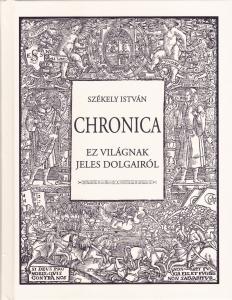
Chronicle. On the Noteworthy Things of This World
Chronicle. On the Noteworthy Things of This World
Written by István Székely
Facsimile edition
Studies written by Hunor Boér and Gábor Farkas Farkas
NSZL–Székely National Museum–Kossuth Publishing House, Budapest, 2019., 237 pages
ISBN 978-963-099-894-9
István Székely’s work Chronica. Ez világnak jeles dolgairól (Chronicle. On the Noteworthy Things of This World), the first universal history written in Hungarian was published in Krakow in 1559. The humanist scholar and reformer – once fellow pastor of Gáspár Károli in Gönc – lists the historical events of the world and of the Hungarians from the genesis until the time of its writing, 1558.
In terms of genre, Székely’s work is a chronology, i.e. a simple listing of important and insignificant events in chronological order. The system and framework of its universal history stems from the concept of biblical origin, initiated by the stories of András Batizi entitled Az drága és istenfélő vitéz Gedeonról szép história (The story of the precious and pious Gideon) (1540) and the Jónás prófétának históriája (The story of prophet Jonah) (1541). According to Székely as well, the Ottomans are a God’s instrument of punishment, who must ruin all Christian countries because of the sin of idolatry (Catholicism). And the last verdict will come once the Ottoman power is broken. Székely enlisted the historical events in chronological order in this particular framework, mostly referring only briefly to actual facts. One of the main aims of his work was to justify the Reformation through historical events, and to demonstrate the complete departure of the Roman Catholic Church from the original Christian teaching – missing not even a single opportunity to express his dissent against the popes and the Roman Catholic Church.
The main work of Székely, which idealized the national kingdom of Matthias Corvinus and took a stand on the Szapolyai House, expressed and strengthened the Protestant national identity of the time. Székely’s chronicle has long been used as one of the most important historians’ handbooks. The precious treasure of Hungarian cultural history is published in a facsimile edition of that certain copy, which was one of the saved volumes of the museum’s collection fled from Sepsiszentgyörgy in 1945. The history of the artwork of the Székely National Museum is presented to the reader through the introduction by Hunor Boér and Gábor Farkas.
Shopping
Our publications are available in our bookshop, or can be ordered from the Publications Department of the NSZL using the contact details below: Főigazgatói Kabinet kiadványtára, Országos Széchényi Könyvtár, 1276 Budapest P.O. box 1205., phone: 06-1-23-23-506, e-mail: kiadvanytar@oszk.hu.




